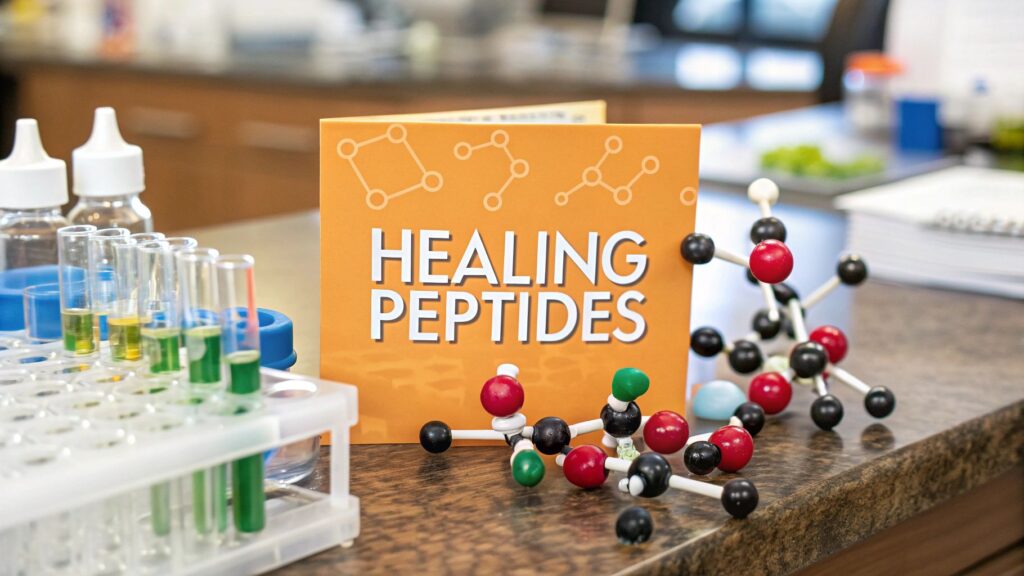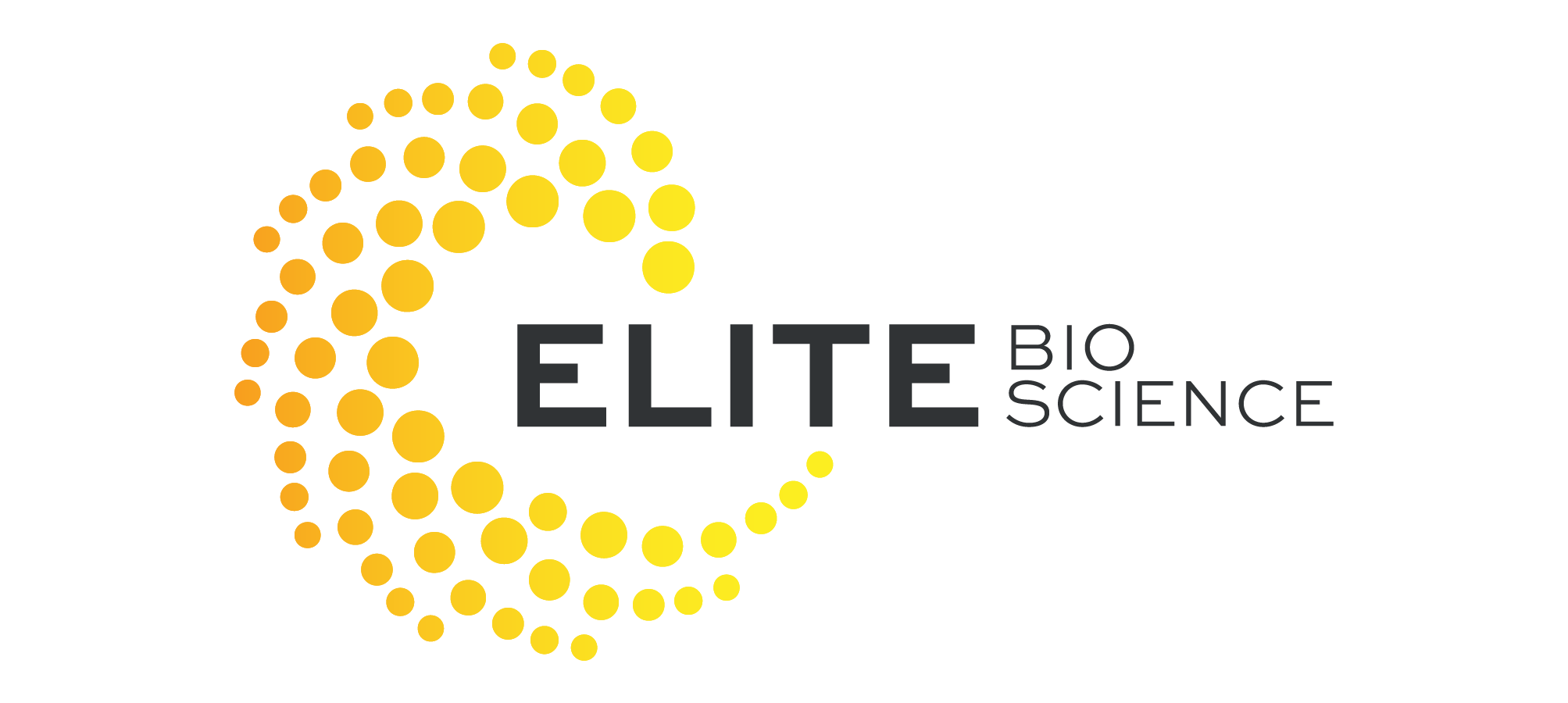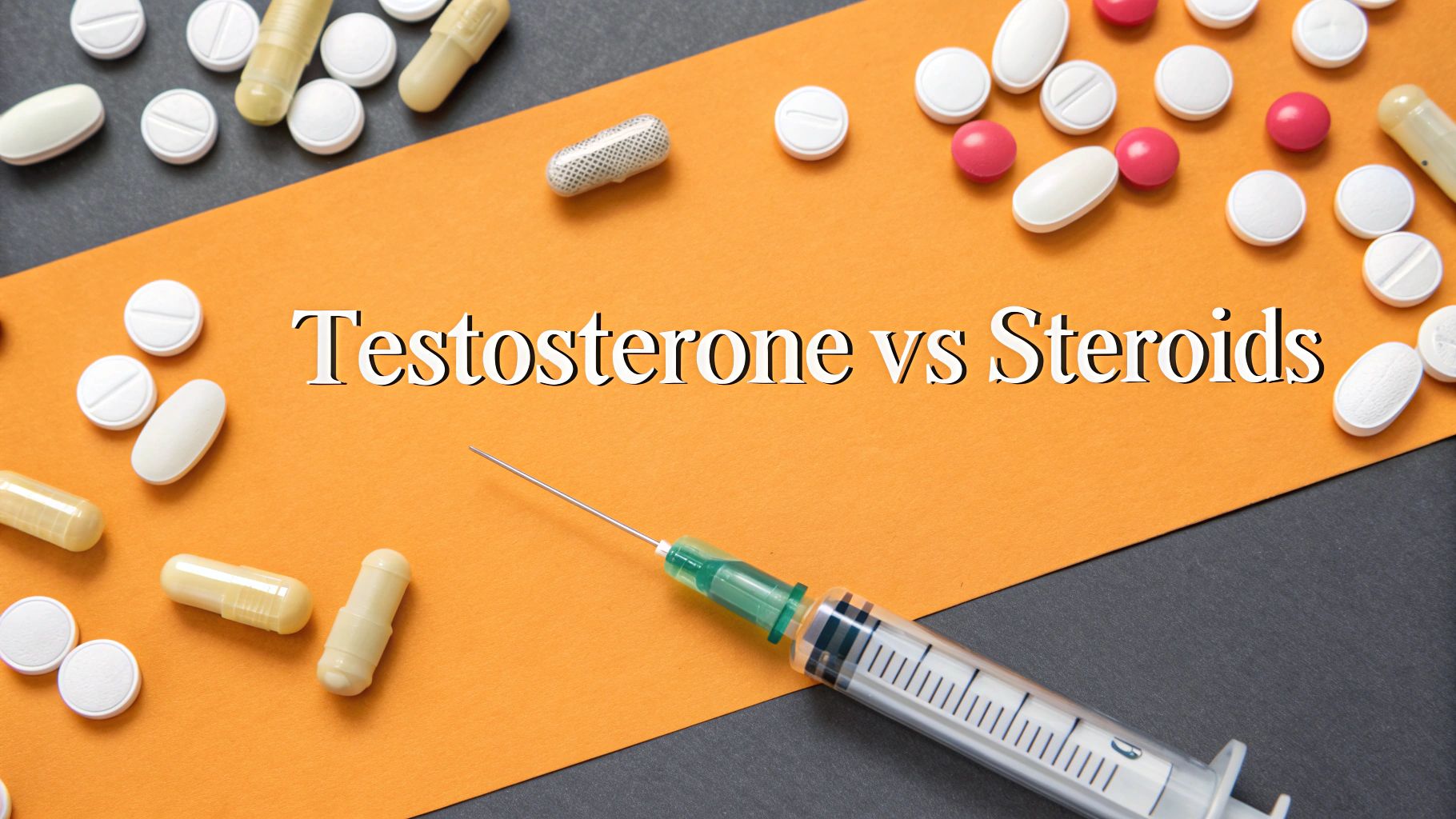BPC 157 and TB 500 A Guide to Healing Peptides

If you’ve been exploring advanced recovery methods, you’ve likely heard the names BPC 157 and TB 500 mentioned together. They’re often stacked for a reason—they work as a powerful one-two punch for tissue repair. BPC 157 is known for its laser-focused, localized healing effects, particularly on stubborn injuries in tendons and the gut. Meanwhile, TB 500 offers broad, systemic support, promoting regeneration across the entire body.
Think of them as a highly specialized surgical team working in perfect harmony.
Unlocking Advanced Healing Protocols
In the search for faster, more complete physical recovery, many are looking past the old standbys of rest and ice. This has opened the door to peptides—short chains of amino acids that act as incredibly precise signaling molecules in your body. In simple terms, they are cellular messengers that tell your body exactly where to send its repair crews, making the entire healing process much more efficient.
The combination of BPC 157 and TB 500 represents one of the leading strategies in this field. But instead of seeing them as interchangeable, it’s far more accurate to view them as complementary tools, each with a very distinct job.
The On-Site Specialist vs. The General Contractor
To really get a feel for how they work together, let's use an analogy. Imagine your body is a large construction project that suddenly has a specific, critical problem—say, a burst pipe deep inside a wall (a torn tendon).
-
BPC 157 is the 'on-site specialist': This peptide goes directly to the burst pipe, bringing specialized tools and materials to fix that single problem with incredible precision. Its main strength is highly targeted, localized repair. To learn more about its specific mechanisms, you can explore our detailed guide on BPC-157 as the ultimate recovery peptide.
-
TB 500 is the 'general contractor': This one doesn’t just fixate on the pipe. It oversees the entire project, improving supply routes (blood vessels), managing inflammation across the whole site, and making sure all the different work crews have the resources they need to operate smoothly. Its strength is systemic, whole-body support.
It's crucial to remember that both BPC 157 and TB 500 are considered research compounds. They are not approved by the FDA for human use, and any consideration of their use should begin with a consultation with a qualified medical professional.
BPC 157 vs TB 500 At a Glance
To quickly summarize their distinct roles, this table offers a straightforward comparison of their key characteristics.
| Feature | BPC-157 | TB-500 |
|---|---|---|
| Primary Action | Localized & Targeted | Systemic & Widespread |
| Best For | Tendons, ligaments, gut health | Muscle repair, reducing inflammation |
| Origin | Derived from a stomach protein | Synthetic version of Thymosin Beta-4 |
| Analogy | On-site specialist | General contractor |
By understanding these differences, it becomes clear why they aren't an "either/or" choice but rather a synergistic pair designed to tackle recovery from two different but complementary angles.
How BPC 157 Works for Targeted Repair

If TB 500 is the general contractor overseeing a system-wide renovation, then BPC 157 is the master foreman on site, laser-focused on a single, critical repair job. Its real power isn't in broad, sweeping action. It's in its incredible ability to zero in on a specific injury site and get to work.
Think about a nagging case of tennis elbow, where one specific tendon is frayed and screaming. BPC 157 doesn't just dial down inflammation across your entire arm. It goes straight to that damaged tendon to kickstart a highly localized and intense repair process. This precision is exactly what makes the BPC 157 and TB 500 combination so powerful.
The Stomach's Secret to Repair
To really get a feel for what BPC 157 can do, you have to know where it comes from. It's a synthetic peptide, but it’s based on a Body Protection Compound that’s naturally swimming around in our own gastric juice. This origin story is the key to one of its most celebrated benefits: gut health.
Your stomach lining is under constant assault from harsh acids. It has to repair itself at an incredible rate just to maintain its integrity. The natural protein that BPC 157 mimics is a central player in that daily defense and maintenance.
This is why BPC 157 is so heavily researched for more than just muscle and joint injuries. It’s also known for supporting the delicate lining of the gut, fortifying that barrier against the stress of intense training or other modern-day irritants.
Fueling the Repair Crew with Angiogenesis
One of the biggest roadblocks to healing any tissue is blood supply. Blood is the delivery truck that brings oxygen, nutrients, and all the raw materials needed for reconstruction. If blood flow is poor, healing grinds to a halt. This is where BPC 157 really shines, through a process called angiogenesis.
Angiogenesis is simply the formation of new blood vessels. Picture the foreman building brand-new access roads directly to the damaged construction site.
- Improved Delivery: These new vessels create a superhighway, allowing repair cells and nutrients to flood the area.
- Waste Removal: They also act as an exit route, clearing out cellular debris and junk that can slow the whole process down.
- Accelerated Timeline: By boosting the local supply chain, BPC 157 can dramatically speed up the rebuilding of tissues like tendons and ligaments—which are notoriously slow healers precisely because they have such a poor natural blood supply.
This mechanism is a huge reason why BPC 157 shows such incredible results in preclinical models of tendon-to-bone healing, one of the toughest recovery challenges out there.
By stimulating the growth of new blood vessels directly at the point of injury, BPC 157 fundamentally changes the local healing environment from one of scarcity to one of abundance, providing the raw materials needed for rapid and robust repair.
Activating the Body's Master Switches
BPC 157 doesn't just build new supply lines; it also flips the switches on key signaling pathways that manage growth and repair. It’s not just dropping off materials at the job site—it's giving the cellular "workers" clear instructions on how to use them.
One of the coolest ways it does this is by influencing the Growth Hormone (GH) receptor. Research suggests BPC 157 can actually increase the number of these receptors on tendon fibroblasts, the very cells responsible for spinning up new tendon tissue.
What that means is, even with the same amount of growth hormone floating around in your system, the cells at the injury site become far more sensitive to its healing signals. It’s like upgrading the crew's radios so they can hear the foreman's orders loud and clear.
This targeted approach—boosting local blood flow, protecting the gut, and amplifying growth signals exactly where they’re needed most—is the essence of how BPC 157 operates. It's a precision tool for stubborn, localized injuries, making it the perfect specialist to complement the systemic, wide-ranging support of TB 500.
Understanding The Systemic Action of TB-500
While BPC-157 acts like a precision foreman, rushing directly to a specific injury site, TB-500 operates on a much grander scale. Think of this peptide—a synthetic version of the naturally occurring protein Thymosin Beta-4—as a system-wide logistics manager. Its primary job isn't to fix one isolated problem; it's to coordinate a healing response across the entire body.
Instead of zeroing in on a single torn tendon, TB-500 works to improve the overall environment for repair. It helps dial down widespread inflammation, mobilizes cellular repair crews, and ensures resources can get where they need to go. This makes it a powerful counterpart when combining BPC-157 and TB-500, addressing both the local damage and the systemic conditions that support recovery.
The Cellular Building Block Manager
At the heart of TB-500’s function is its relationship with a crucial protein called actin. Picture actin as the fundamental Lego brick of your cells. It's a key component of the cellular skeleton, providing structure and—more importantly—enabling cells to move, change shape, and migrate where they're needed.
When an injury occurs, cells need to travel to the damaged area to begin repairs. TB-500 acts like a traffic controller for actin, helping regulate its availability. By doing so, it allows cells, like those that form new blood vessels or muscle fibers, to move more freely and efficiently, speeding up their arrival at injury sites throughout the body.
This broad influence on cellular mobility is exactly why TB-500 is associated with widespread tissue regeneration rather than just a single point of repair.
A Master of Systemic Angiogenesis
Just like BPC-157, TB-500 is a potent driver of angiogenesis, the creation of new blood vessels. But its approach is completely different. While BPC-157 builds new access roads directly to one damaged structure, TB-500 works to upgrade the entire highway system, improving blood flow on a much larger scale.
This has several key benefits for recovery:
- Widespread Nutrient Delivery: Enhanced circulation means more oxygen and nutrients can reach multiple areas of tissue damage at the same time.
- Reduced Systemic Inflammation: Better blood flow helps flush out inflammatory byproducts from the entire system, not just one location.
- Support for Large Muscle Groups: This is incredibly valuable for athletes recovering from intense training that causes micro-trauma across large muscle groups.
By promoting this broad vascular remodeling, TB-500 lays the groundwork for efficient, body-wide repair.
Contrasting the Healing Philosophies
The difference in how these peptides work is a key reason they are so often studied together. BPC-157 is renowned for its specialized role in repairing specific tissues like ligaments, tendons, and the gut lining. In contrast, TB-500 is recognized for its broader, systemic actions that promote new blood vessel formation and speed up soft tissue recovery across the body.
This contrast is central to understanding how to best use their properties for different recovery goals.
TB-500’s systemic action is like turning on the sprinklers for the entire lawn, ensuring every blade of grass gets the water it needs. BPC-157 is the gardener who gives extra water directly to one wilting plant. Both actions are vital for a healthy garden.
This dual-action approach—local precision from BPC-157 and systemic support from TB-500—creates a robust framework for healing. When used in tandem, one addresses the acute problem while the other optimizes the entire biological environment for a faster, more complete recovery. If you're interested in a deeper exploration of its capabilities, our guide on TB-500 peptide benefits offers a more detailed look.
Stacking BPC 157 and TB 500 for Synergy
Using BPC-157 or TB-500 on its own can offer some impressive, targeted benefits. But when you run them together in a stack, you unlock a powerful synergy that takes recovery to a whole new level. This is where you see the true potential of a well-designed peptide protocol come to life, creating a healing environment far more robust than what either compound can achieve alone.
Let's go back to our construction site analogy. If a critical pipe bursts, you absolutely need the specialized foreman (BPC-157) on-site immediately to stop the leak and start patching things up. But that foreman's work will be slow and clumsy if the general contractor (TB-500) hasn't cleared the access roads, managed the site-wide chaos, and made sure a steady flow of materials can get through.
When you stack them, the foreman works on the precise problem while the contractor optimizes the entire project. BPC-157 provides the localized, intense repair signals right where you need them, while TB-500 tackles systemic inflammation and mobilizes the body's resources for a coordinated, efficient response.
Why Stacking Amplifies Healing
The real magic of stacking these two lies in how their mechanisms of action complement each other. BPC-157 is the star player for targeted tissue regeneration, especially in tricky areas with poor blood flow like tendons and ligaments. It works by directly stimulating the growth of new blood vessels right at the injury site.
At the same time, TB-500 promotes systemic angiogenesis, essentially upgrading the entire circulatory network around the body. This makes sure that the new local pathways built by BPC-157 are well-supplied and integrated. It’s a perfect partnership that addresses recovery on both the micro and macro levels.
Common goals for stacking these peptides often include:
- Accelerating Post-Surgical Recovery: Giving the body the tools it needs to bounce back after invasive procedures.
- Managing Chronic Injuries: Addressing stubborn issues like nagging tendonitis that haven't responded to conventional treatments.
- Supporting Intense Athletic Training: Helping to mitigate the systemic stress and micro-trauma that come from rigorous physical activity.
This visual gives you a great idea of the kind of performance improvements and healing acceleration that researchers have observed when combining these powerful peptides.

The data from preclinical studies is pretty clear, showing a dramatic reduction in healing time and a significant boost in key biological markers for repair when compared to the body's normal processes.
Practical Administration and Dosing Protocols
Getting the administration right is absolutely key to getting the most out of a BPC-157 and TB-500 stack. Both peptides usually arrive as a lyophilized (freeze-dried) powder and must be reconstituted with bacteriostatic water before you can use them. This process involves carefully injecting the water into the vial and gently swirling it—never shaking—until the powder is completely dissolved.
Injections are typically administered subcutaneously, which means just under the skin. The abdomen or another area with a bit of fatty tissue is a common spot. For BPC-157, some protocols suggest injecting as close to the injury site as possible to maximize its localized effects, though it's important to remember that it still provides systemic benefits no matter where it's administered.
It is absolutely essential to approach peptide use with caution. All protocols should be considered within a research context and discussed with a qualified healthcare professional who can provide guidance based on individual health needs.
Dosage protocols can vary quite a bit depending on the specific goal, the severity of an injury, and how an individual responds. However, a combination of research and anecdotal reports from the biohacking community has helped establish some common starting points.
Below is a table that outlines some sample stacking protocols for different scenarios. Keep in mind these are for informational purposes only and are not a substitute for professional medical advice.
Sample BPC 157 and TB 500 Stacking Protocols
| Goal | BPC-157 Dosage (mcg) | TB-500 Dosage (mg) | Frequency | Cycle Duration |
|---|---|---|---|---|
| Acute Injury | 250-500 daily | 2-2.5 twice weekly | BPC daily, TB 500 twice weekly | 4-6 Weeks |
| General Recovery | 250 daily | 2 twice weekly | BPC daily, TB 500 twice weekly | 4-8 Weeks |
| Post-Surgery | 500 daily | 2.5 twice weekly | BPC daily, TB 500 twice weekly | 6-8 Weeks |
| Chronic Condition | 250 twice daily | 2.5 twice weekly | BPC twice daily, TB 500 twice weekly | 8-12 Weeks |
By combining the targeted precision of BPC-157 with the systemic support of TB-500, researchers can create a truly multifaceted healing strategy. This synergistic approach ensures that both the specific point of injury and the entire body are primed for optimal recovery, potentially leading to faster and more complete results.
Navigating the Safety and Legal Landscape

While the healing potential of peptides like BPC-157 and TB-500 is compelling, we have to talk about the realities of their safety and legal status. It's not a straightforward topic. These aren't over-the-counter supplements; they exist in a complex gray area, and being transparent about that is the only responsible way to approach them.
When combining BPC-157 and TB-500, the most frequently reported side effects are thankfully minor. Anecdotal reports and discussions in research forums often point to mild irritation, a bit of redness, or some swelling right at the injection site. Some people also mention feeling temporary fatigue or a little lightheadedness as their bodies get used to the peptides.
But here’s the critical part: just because preclinical studies haven't flagged widespread, severe side effects doesn't mean these compounds are risk-free. The truth is, the long-term effects of these peptides in humans are still a big unknown, which is exactly why caution is so important.
The Unregulated Market and Purity Concerns
One of the biggest gambles with these peptides is where you get them from. Since they aren't approved by the FDA for human use, they're sold almost exclusively online by vendors who operate in a completely unregulated market. This creates a dangerous "buyer beware" scenario.
When you buy from these channels, there's absolutely no guarantee of:
- Purity: The vial you get could be under-dosed or, worse, contain none of the active peptide at all.
- Contamination: Improper manufacturing can lead to vials tainted with bacteria, heavy metals, or other harmful junk.
- Accuracy: The substance in the vial might not even be what you think you're buying.
The lack of oversight means the burden of verifying a product's quality and safety falls squarely on you, the consumer. That's a huge risk, because impurities can cause nasty reactions or just make the peptide totally ineffective.
The FDA's Stance on BPC 157
The regulatory environment around BPC-157, in particular, has tightened up significantly. This isn’t just about a lack of approval; the FDA has taken a very clear and critical position on its use, reflecting growing concerns in the medical community.
In late 2023, the FDA officially classified BPC-157 as a substance that presents "significant safety risks." They pointed to a lack of solid safety data and the potential for adverse immune reactions. This action effectively banned the peptide from being legally compounded in pharmacies under federal law. This move followed federal prosecution against several compounding pharmacies between 2018 and 2020 for distributing unapproved drugs.
This classification sends a powerful signal. It highlights the perceived risks and underscores the absence of proper human safety trials. It also makes it clear that self-administering this peptide goes directly against federal guidelines. Before even considering this path, it's essential to understand the broader context of whether peptide therapy is safe in the first place.
The Absolute Need for Medical Guidance
Trying to navigate this world on your own is simply a bad idea. The complexities of dosing, the real dangers of sourcing, and the unknown long-term effects make professional medical guidance non-negotiable.
A qualified physician can help you weigh the potential benefits against the very real risks as they apply to your specific health situation. They can look at your overall health, flag any potential red flags or contraindications, and give you a realistic perspective grounded in actual medical science—not just what you read on a forum. This professional oversight is the single most important safety measure you can take.
The Future of Regenerative Peptide Therapy

The incredible buzz around peptides like BPC-157 and TB-500 isn't happening in a vacuum. It’s part of a much bigger shift in medicine toward regenerative therapies—a move away from just managing symptoms to fundamentally repairing damaged tissue from the inside out.
Peptides are really at the heart of this movement. They're being studied for everything from metabolic conditions to brain health and, of course, the kind of accelerated tissue repair we've been talking about. Think of peptides as biological keys, precision-cut to unlock very specific healing pathways in the body. That’s why they’re attracting so much scientific and financial attention.
A Rapidly Expanding Field
The growth in the peptide therapeutics market tells a compelling story. This isn't some fringe area of science anymore; it's a major focus of pharmaceutical development.
As of 2024, the global market for peptide therapeutics was valued at around $50 billion. Projections show it climbing to nearly $83.75 billion by 2034. That kind of growth is driven by serious research into treatments for a huge range of conditions. You can find more details about the growing peptide market at Innerbody.com.
This financial momentum shows a strong belief that peptides are on their way to becoming mainstream medical tools.
Grounding Hype in Reality
It’s crucial, however, to keep our feet on the ground. A lot of the current excitement around BPC-157 and TB-500 is built on preclinical studies and powerful anecdotal reports from users. While these are incredibly promising, they aren't the same as large-scale, rigorous human clinical trials.
The path from a promising research compound to an approved medical treatment is long and demanding. The next essential step for peptides like BPC-157 is to undergo comprehensive human studies to definitively confirm their safety profiles and prove they work under controlled conditions.
What's Next?
The future of regenerative medicine is bright, and peptides will undoubtedly be a huge part of it. As the science continues to move forward, we can expect to see more of these compounds make the leap from the lab to the clinic, offering real solutions for injuries and chronic issues that were once so hard to manage.
For now, the best thing to do is stay informed, look at the current data with a critical eye, and always follow the guidance of a qualified medical professional. The story of BPC-157 and TB-500 is still being written, and the next chapters will depend entirely on the results of dedicated scientific research.
Your Questions Answered
When you're diving into the world of research peptides, it’s natural for practical questions to come up. Let's cut through the noise and get straight to the point on some of the most common queries about BPC 157 and TB 500, so you know exactly what to expect.
Can I Use Just One Peptide Instead of Stacking Them?
Yes, absolutely. While stacking BPC 157 and TB 500 is a powerful strategy for tackling complex or widespread injuries, it’s definitely not a requirement. Each of these peptides is a heavy hitter on its own.
BPC 157, for instance, is often used as a standalone compound for very localized issues. Think of it as a precision tool for things like a nagging case of tendonitis, a specific ligament strain, or even supporting the lining of your gut. Its focused action makes it perfect for these kinds of targeted applications.
On the other hand, TB 500 is your go-to when the goal is more systemic. Researchers often use it by itself for things like accelerating muscle recovery after intense workouts, calming widespread inflammation, or just improving overall tissue regeneration. The decision to stack really comes down to the specific goals you're trying to achieve.
How Long Until I Might See Results?
This is one of the most common questions, and the honest answer is: it varies. The timeline for noticing any changes depends heavily on the severity of the injury, the specific dosing protocol, and your own unique body chemistry. There's no magic one-size-fits-all answer here.
Some people anecdotally report feeling subtle improvements—maybe a little less pain or a bit more mobility—within the first one to two weeks.
However, for the kind of deep tissue repair and comprehensive healing these peptides are known for, a research cycle of at least 4 to 6 weeks is far more realistic. Patience is a must; these compounds are designed to support your body's natural, gradual healing processes, not provide an overnight fix.
Are There Natural Alternatives to These Peptides?
While no natural supplement can perfectly mimic the specific molecular actions of BPC 157 or TB 500, you can definitely support similar healing pathways with the right strategies and supplements. Think of these as excellent complements to a healthy, recovery-focused lifestyle.
- Collagen: This provides the raw building blocks your body needs to repair connective tissues like tendons, ligaments, and cartilage.
- Curcumin (from Turmeric): A well-known and powerful natural anti-inflammatory that can do wonders for managing pain and swelling.
- Omega-3 Fatty Acids: Famous for their ability to help regulate the body's inflammatory response and support overall joint health.
And of course, don't forget the basics. Foundational practices like solid nutrition, getting enough rest, and sticking with targeted physical therapy are still the absolute cornerstones of any effective recovery plan.
At Elite Bioscience, we're committed to providing high-quality, third-party tested therapeutic compounds to help you reach your health and recovery goals. To see our rigorously vetted peptide therapies and find a protocol that fits your needs, please visit us at Elite Bioscience.
QUICK SEARCH
Make an account today to start your journey towards a better and healthier lifestyle.






